Alan Wee-Chung Liew
OASIS: Harnessing Diffusion Adversarial Network for Ocean Salinity Imputation using Sparse Drifter Trajectories
Aug 29, 2025Abstract:Ocean salinity plays a vital role in circulation, climate, and marine ecosystems, yet its measurement is often sparse, irregular, and noisy, especially in drifter-based datasets. Traditional approaches, such as remote sensing and optimal interpolation, rely on linearity and stationarity, and are limited by cloud cover, sensor drift, and low satellite revisit rates. While machine learning models offer flexibility, they often fail under severe sparsity and lack principled ways to incorporate physical covariates without specialized sensors. In this paper, we introduce the OceAn Salinity Imputation System (OASIS), a novel diffusion adversarial framework designed to address these challenges.
Graph Retrieval-Augmented LLM for Conversational Recommendation Systems
Mar 09, 2025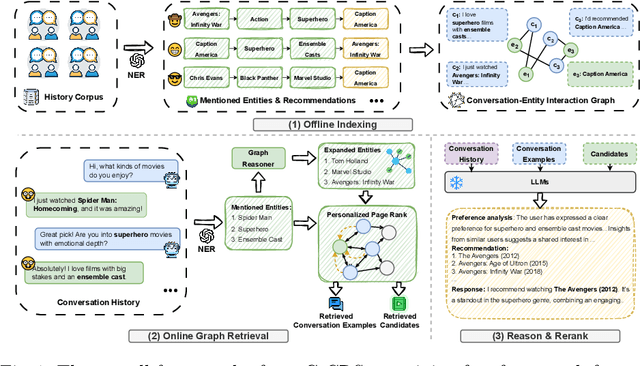
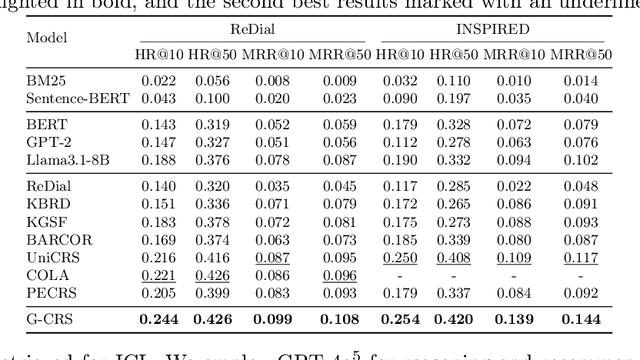
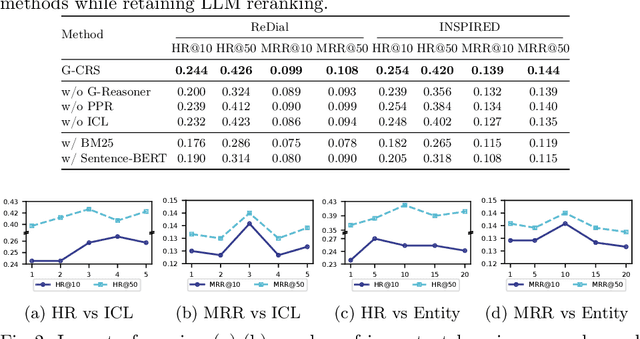
Abstract:Conversational Recommender Systems (CRSs) have emerged as a transformative paradigm for offering personalized recommendations through natural language dialogue. However, they face challenges with knowledge sparsity, as users often provide brief, incomplete preference statements. While recent methods have integrated external knowledge sources to mitigate this, they still struggle with semantic understanding and complex preference reasoning. Recent Large Language Models (LLMs) demonstrate promising capabilities in natural language understanding and reasoning, showing significant potential for CRSs. Nevertheless, due to the lack of domain knowledge, existing LLM-based CRSs either produce hallucinated recommendations or demand expensive domain-specific training, which largely limits their applicability. In this work, we present G-CRS (Graph Retrieval-Augmented Large Language Model for Conversational Recommender Systems), a novel training-free framework that combines graph retrieval-augmented generation and in-context learning to enhance LLMs' recommendation capabilities. Specifically, G-CRS employs a two-stage retrieve-and-recommend architecture, where a GNN-based graph reasoner first identifies candidate items, followed by Personalized PageRank exploration to jointly discover potential items and similar user interactions. These retrieved contexts are then transformed into structured prompts for LLM reasoning, enabling contextually grounded recommendations without task-specific training. Extensive experiments on two public datasets show that G-CRS achieves superior recommendation performance compared to existing methods without requiring task-specific training.
A Label-Free Heterophily-Guided Approach for Unsupervised Graph Fraud Detection
Feb 18, 2025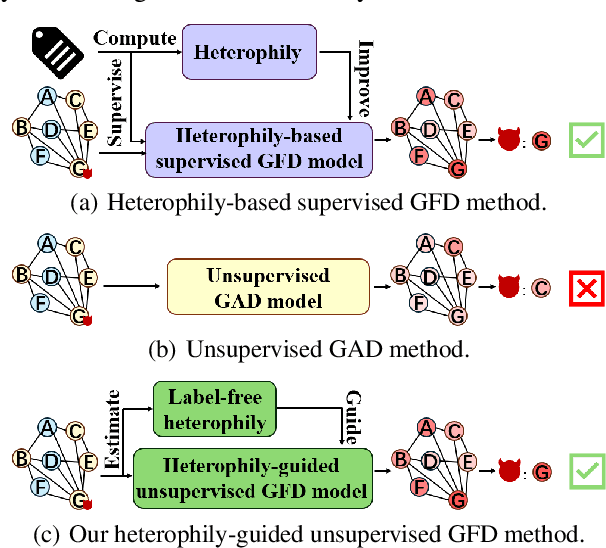

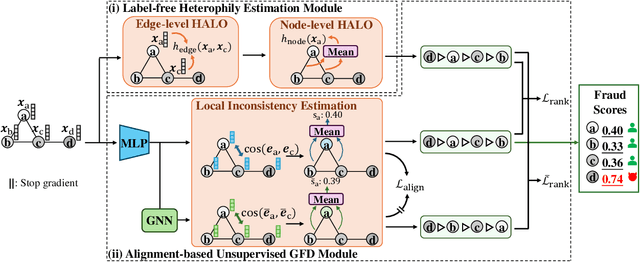

Abstract:Graph fraud detection (GFD) has rapidly advanced in protecting online services by identifying malicious fraudsters. Recent supervised GFD research highlights that heterophilic connections between fraudsters and users can greatly impact detection performance, since fraudsters tend to camouflage themselves by building more connections to benign users. Despite the promising performance of supervised GFD methods, the reliance on labels limits their applications to unsupervised scenarios; Additionally, accurately capturing complex and diverse heterophily patterns without labels poses a further challenge. To fill the gap, we propose a Heterophily-guided Unsupervised Graph fraud dEtection approach (HUGE) for unsupervised GFD, which contains two essential components: a heterophily estimation module and an alignment-based fraud detection module. In the heterophily estimation module, we design a novel label-free heterophily metric called HALO, which captures the critical graph properties for GFD, enabling its outstanding ability to estimate heterophily from node attributes. In the alignment-based fraud detection module, we develop a joint MLP-GNN architecture with ranking loss and asymmetric alignment loss. The ranking loss aligns the predicted fraud score with the relative order of HALO, providing an extra robustness guarantee by comparing heterophily among non-adjacent nodes. Moreover, the asymmetric alignment loss effectively utilizes structural information while alleviating the feature-smooth effects of GNNs.Extensive experiments on 6 datasets demonstrate that HUGE significantly outperforms competitors, showcasing its effectiveness and robustness. The source code of HUGE is at https://github.com/CampanulaBells/HUGE-GAD.
Privacy-Preserving in Medical Image Analysis: A Review of Methods and Applications
Dec 05, 2024
Abstract:With the rapid advancement of artificial intelligence and deep learning, medical image analysis has become a critical tool in modern healthcare, significantly improving diagnostic accuracy and efficiency. However, AI-based methods also raise serious privacy concerns, as medical images often contain highly sensitive patient information. This review offers a comprehensive overview of privacy-preserving techniques in medical image analysis, including encryption, differential privacy, homomorphic encryption, federated learning, and generative adversarial networks. We explore the application of these techniques across various medical image analysis tasks, such as diagnosis, pathology, and telemedicine. Notably, we organizes the review based on specific challenges and their corresponding solutions in different medical image analysis applications, so that technical applications are directly aligned with practical issues, addressing gaps in the current research landscape. Additionally, we discuss emerging trends, such as zero-knowledge proofs and secure multi-party computation, offering insights for future research. This review serves as a valuable resource for researchers and practitioners and can help advance privacy-preserving in medical image analysis.
Unveiling User Preferences: A Knowledge Graph and LLM-Driven Approach for Conversational Recommendation
Nov 16, 2024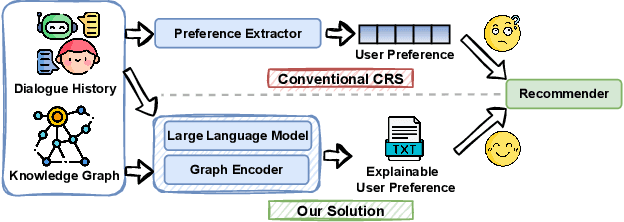
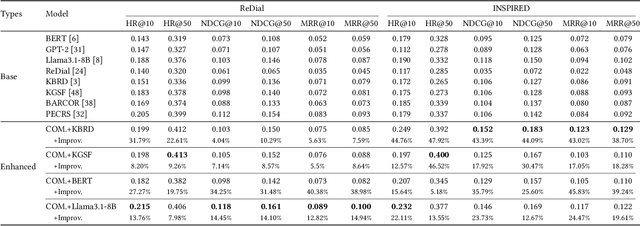
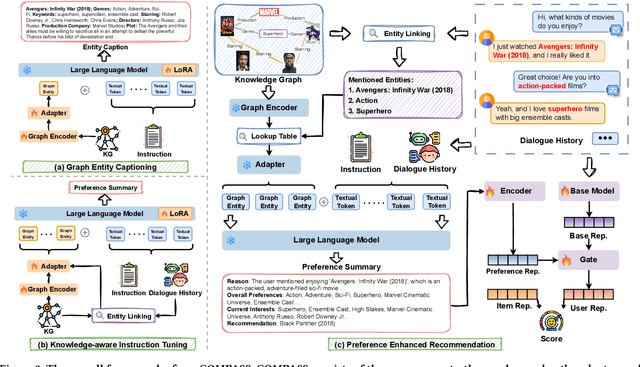
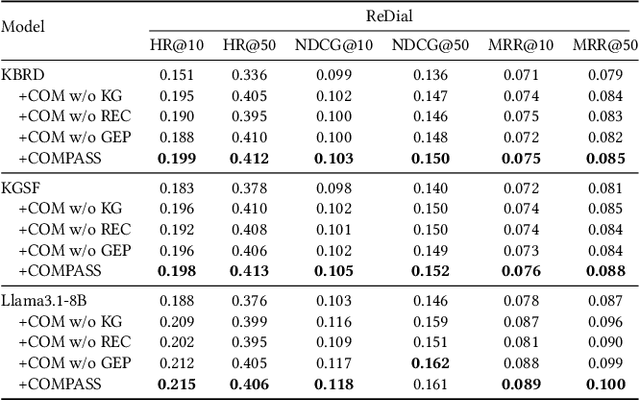
Abstract:Conversational Recommender Systems (CRSs) aim to provide personalized recommendations through dynamically capturing user preferences in interactive conversations. Conventional CRSs often extract user preferences as hidden representations, which are criticized for their lack of interpretability. This diminishes the transparency and trustworthiness of the recommendation process. Recent works have explored combining the impressive capabilities of Large Language Models (LLMs) with the domain-specific knowledge of Knowledge Graphs (KGs) to generate human-understandable recommendation explanations. Despite these efforts, the integration of LLMs and KGs for CRSs remains challenging due to the modality gap between unstructured dialogues and structured KGs. Moreover, LLMs pre-trained on large-scale corpora may not be well-suited for analyzing user preferences, which require domain-specific knowledge. In this paper, we propose COMPASS, a plug-and-play framework that synergizes LLMs and KGs to unveil user preferences, enhancing the performance and explainability of existing CRSs. To address integration challenges, COMPASS employs a two-stage training approach: first, it bridges the gap between the structured KG and natural language through an innovative graph entity captioning pre-training mechanism. This enables the LLM to transform KG entities into concise natural language descriptions, allowing them to comprehend domain-specific knowledge. Following, COMPASS optimizes user preference modeling via knowledge-aware instruction fine-tuning, where the LLM learns to reason and summarize user preferences from both dialogue histories and KG-augmented context. This enables COMPASS to perform knowledge-aware reasoning and generate comprehensive and interpretable user preferences that can seamlessly integrate with existing CRS models for improving recommendation performance and explainability.
GPU Based Differential Evolution: New Insights and Comparative Study
May 26, 2024Abstract:Differential Evolution (DE) is a highly successful population based global optimisation algorithm, commonly used for solving numerical optimisation problems. However, as the complexity of the objective function increases, the wall-clock run-time of the algorithm suffers as many fitness function evaluations must take place to effectively explore the search space. Due to the inherently parallel nature of the DE algorithm, graphics processing units (GPU) have been used to effectively accelerate both the fitness evaluation and DE algorithm. This work reviews the main architectural choices made in the literature for GPU based DE algorithms and introduces a new GPU based numerical optimisation benchmark to evaluate and compare GPU based DE algorithms.
Large Language Models-guided Dynamic Adaptation for Temporal Knowledge Graph Reasoning
May 23, 2024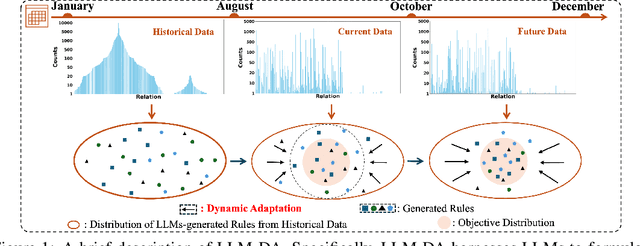
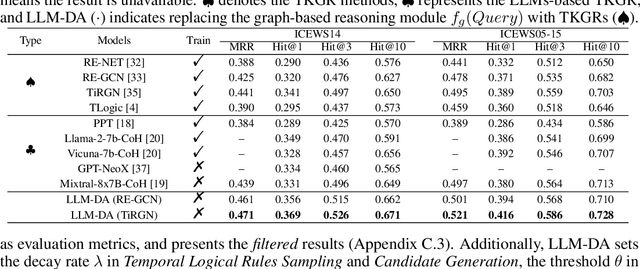
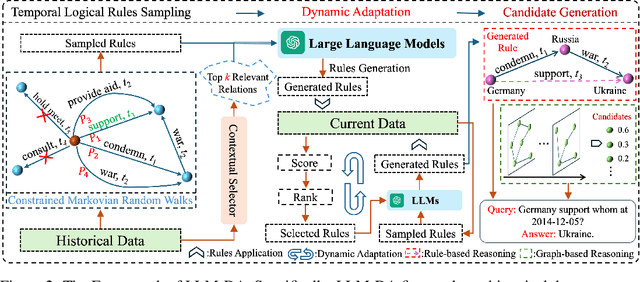

Abstract:Temporal Knowledge Graph Reasoning (TKGR) is the process of utilizing temporal information to capture complex relations within a Temporal Knowledge Graph (TKG) to infer new knowledge. Conventional methods in TKGR typically depend on deep learning algorithms or temporal logical rules. However, deep learning-based TKGRs often lack interpretability, whereas rule-based TKGRs struggle to effectively learn temporal rules that capture temporal patterns. Recently, Large Language Models (LLMs) have demonstrated extensive knowledge and remarkable proficiency in temporal reasoning. Consequently, the employment of LLMs for Temporal Knowledge Graph Reasoning (TKGR) has sparked increasing interest among researchers. Nonetheless, LLMs are known to function as black boxes, making it challenging to comprehend their reasoning process. Additionally, due to the resource-intensive nature of fine-tuning, promptly updating LLMs to integrate evolving knowledge within TKGs for reasoning is impractical. To address these challenges, in this paper, we propose a Large Language Models-guided Dynamic Adaptation (LLM-DA) method for reasoning on TKGs. Specifically, LLM-DA harnesses the capabilities of LLMs to analyze historical data and extract temporal logical rules. These rules unveil temporal patterns and facilitate interpretable reasoning. To account for the evolving nature of TKGs, a dynamic adaptation strategy is proposed to update the LLM-generated rules with the latest events. This ensures that the extracted rules always incorporate the most recent knowledge and better generalize to the predictions on future events. Experimental results show that without the need of fine-tuning, LLM-DA significantly improves the accuracy of reasoning over several common datasets, providing a robust framework for TKGR tasks.
LiDAR-Guided Cross-Attention Fusion for Hyperspectral Band Selection and Image Classification
Apr 15, 2024



Abstract:The fusion of hyperspectral and LiDAR data has been an active research topic. Existing fusion methods have ignored the high-dimensionality and redundancy challenges in hyperspectral images, despite that band selection methods have been intensively studied for hyperspectral image (HSI) processing. This paper addresses this significant gap by introducing a cross-attention mechanism from the transformer architecture for the selection of HSI bands guided by LiDAR data. LiDAR provides high-resolution vertical structural information, which can be useful in distinguishing different types of land cover that may have similar spectral signatures but different structural profiles. In our approach, the LiDAR data are used as the "query" to search and identify the "key" from the HSI to choose the most pertinent bands for LiDAR. This method ensures that the selected HSI bands drastically reduce redundancy and computational requirements while working optimally with the LiDAR data. Extensive experiments have been undertaken on three paired HSI and LiDAR data sets: Houston 2013, Trento and MUUFL. The results highlight the superiority of the cross-attention mechanism, underlining the enhanced classification accuracy of the identified HSI bands when fused with the LiDAR features. The results also show that the use of fewer bands combined with LiDAR surpasses the performance of state-of-the-art fusion models.
* 15 pages, 13 figures
Knowledge Graphs and Pre-trained Language Models enhanced Representation Learning for Conversational Recommender Systems
Dec 27, 2023



Abstract:Conversational recommender systems (CRS) utilize natural language interactions and dialogue history to infer user preferences and provide accurate recommendations. Due to the limited conversation context and background knowledge, existing CRSs rely on external sources such as knowledge graphs to enrich the context and model entities based on their inter-relations. However, these methods ignore the rich intrinsic information within entities. To address this, we introduce the Knowledge-Enhanced Entity Representation Learning (KERL) framework, which leverages both the knowledge graph and a pre-trained language model to improve the semantic understanding of entities for CRS. In our KERL framework, entity textual descriptions are encoded via a pre-trained language model, while a knowledge graph helps reinforce the representation of these entities. We also employ positional encoding to effectively capture the temporal information of entities in a conversation. The enhanced entity representation is then used to develop a recommender component that fuses both entity and contextual representations for more informed recommendations, as well as a dialogue component that generates informative entity-related information in the response text. A high-quality knowledge graph with aligned entity descriptions is constructed to facilitate our study, namely the Wiki Movie Knowledge Graph (WikiMKG). The experimental results show that KERL achieves state-of-the-art results in both recommendation and response generation tasks.
Towards Data-centric Graph Machine Learning: Review and Outlook
Sep 20, 2023
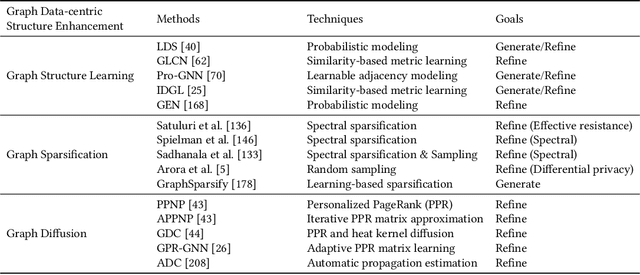
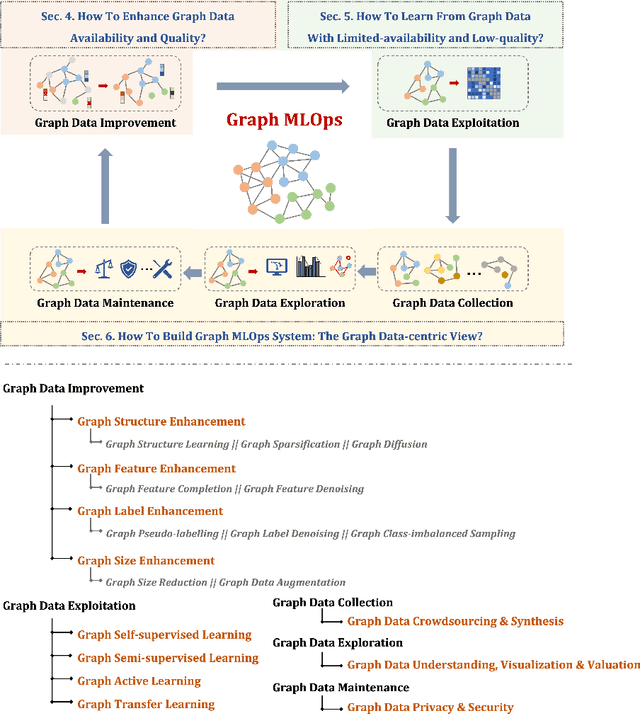
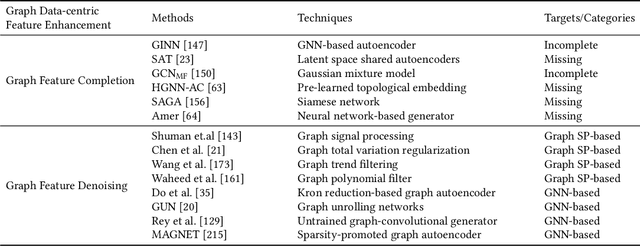
Abstract:Data-centric AI, with its primary focus on the collection, management, and utilization of data to drive AI models and applications, has attracted increasing attention in recent years. In this article, we conduct an in-depth and comprehensive review, offering a forward-looking outlook on the current efforts in data-centric AI pertaining to graph data-the fundamental data structure for representing and capturing intricate dependencies among massive and diverse real-life entities. We introduce a systematic framework, Data-centric Graph Machine Learning (DC-GML), that encompasses all stages of the graph data lifecycle, including graph data collection, exploration, improvement, exploitation, and maintenance. A thorough taxonomy of each stage is presented to answer three critical graph-centric questions: (1) how to enhance graph data availability and quality; (2) how to learn from graph data with limited-availability and low-quality; (3) how to build graph MLOps systems from the graph data-centric view. Lastly, we pinpoint the future prospects of the DC-GML domain, providing insights to navigate its advancements and applications.
 Add to Chrome
Add to Chrome Add to Firefox
Add to Firefox Add to Edge
Add to Edge